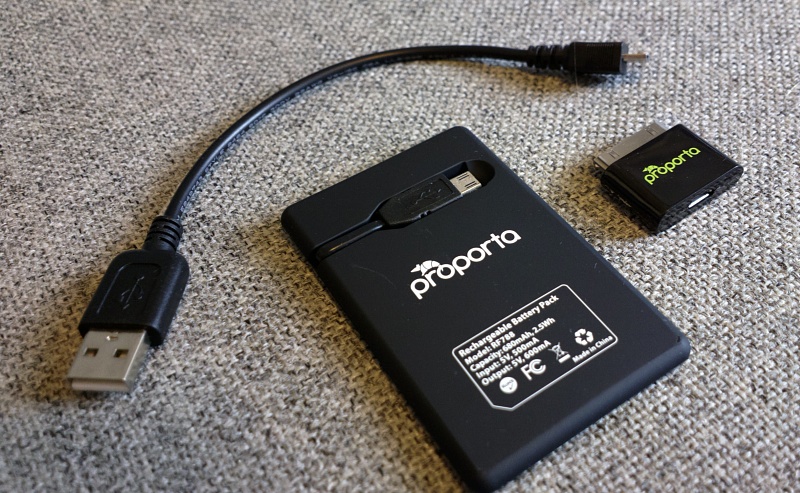It all started with the Proporta Pocket Power (shown below), which you'll remember from my review. A very popular little gadget, what I loved most about it was that the charging lead for output was integral, i.e. it was self-contained, with no cable to lose. In fact, I still carry a Pocket Power in my wallet to this day - and no, you can't buy them anymore, rather sadly. (Do let me know if anyone spots an exact clone online anywhere!)

Although fully integral, the Pocket Power did come (somewhat unnecessarily in my case) with an extra lead for charging itself from another source and an iPhone adapter....
In search of something similar, my eye was caught by Mobile Fun's new Olixar Powercard and by this "2500mAh Ultra Thin Power Bank" from yi-digital (via eBay). So I got both in for testing:

As you can see from the photo, the genuinely credit-card-sized Olixar Powercard does require an extra cable, taking power from full size USB in one corner of the card to microUSB, while the 'Ultra Thin' (rather larger, though would still fit in the bill-fold section of most wallets) contains a flying lead in similar style to the original Pocket Power, plus the extra short lead for charging the power bank and a handy microUSB to Apple Lightning adapter.
Aside from actual performance, there's also usually a mechanism for showing you, the user, the current charge within. The Olixar Powercard has a three LED system (0-30%, 30%-60%, 60%-100%), accessed by pressing and holding a tiny button in the side of the accessory, while the 'Ultra Thin' simply has a single red LED that flashes when it's on charge and stops flashing when it's full. There's no way to check charge when it's not connected, rather disappointingly.
So far, the Pocket Power still has the edge then, but where the new generation of wallet chargers score is in absolute capacity. I measured the amount each was able to deliver in replenishing a variety of my Nokia collection and averaged out to yield the values in the table below:
Note: something which is becoming increasingly obvious with charger specs is that they're quoted as the capacity of the internal cells at their native voltage, i.e. 3.7V. In order to charge something else, this needs raising to the USB standard of 5V. Not only does this introduce more inefficiencies in terms of power loss, but it also means that the real capacity at 5V is roughly 25% less. In the table below I've included a column for this, and will endeavour to do so for future power banks, to be absolutely clear.
| Nominal capacity (at 3.7V) | Best capacity at 5V | Approx. actual delivered charge (over 2 test cycles) | Nominal efficiency based on 'best' spec(!) | Cost | |
| Proporta Pocket Power | 680mAh | 500mAh | 320mAh | 64% | no longer a/v |
| Olixar Powercard | 1500mAh | 1100mAh | 700mAh | 64% | £15 |
| Ultra Thin Power Bank | 2500mAh | 1800mAh | 950mAh | 52% | £6 |
I've usually worked on the premise that transferring charge from one battery to another in this manner lost about 30% (via heat, mainly) in the process, but it does seem that even this estimate is on the low side, and that at worst case efficiency can be as low as 50%. The losses are in the ramp up to 5V inside the charger, in the cables and output circuits, and in the receiving circuits and battery, which obviously gets warmer.
It should also be noted that these solutions all charge quite slowly, with typical 'input' ratings of 5V at 500mA - we're used to phones and tablets charging at between 1A and 2A these days, so an hour or two to charge a wallet charger seems a bit excessive!
The takeaway here is that you should take the 'mAh' ratings on product pages with a huge pinch of salt. They almost always refer to the 'internal' capacity at 3.7V, so knock off 25% or so in your head as you browse the specs. And then knock off another third in energy wastage, to get to the actual potential 'delivered' charge.
The Olixar card above is the higher quality of the two on text, but pricier and you have to carry around the small cable, while the 'Ultra Thin' (unbranded) card is definitely of lower quality and efficiency but is integral and cheaper. Your call!
Personally, I'm still on the hunt for a quality wallet charger that has a flying lead, charge indication and around 1000mAh delivered capacity (at 5V). What about you?
